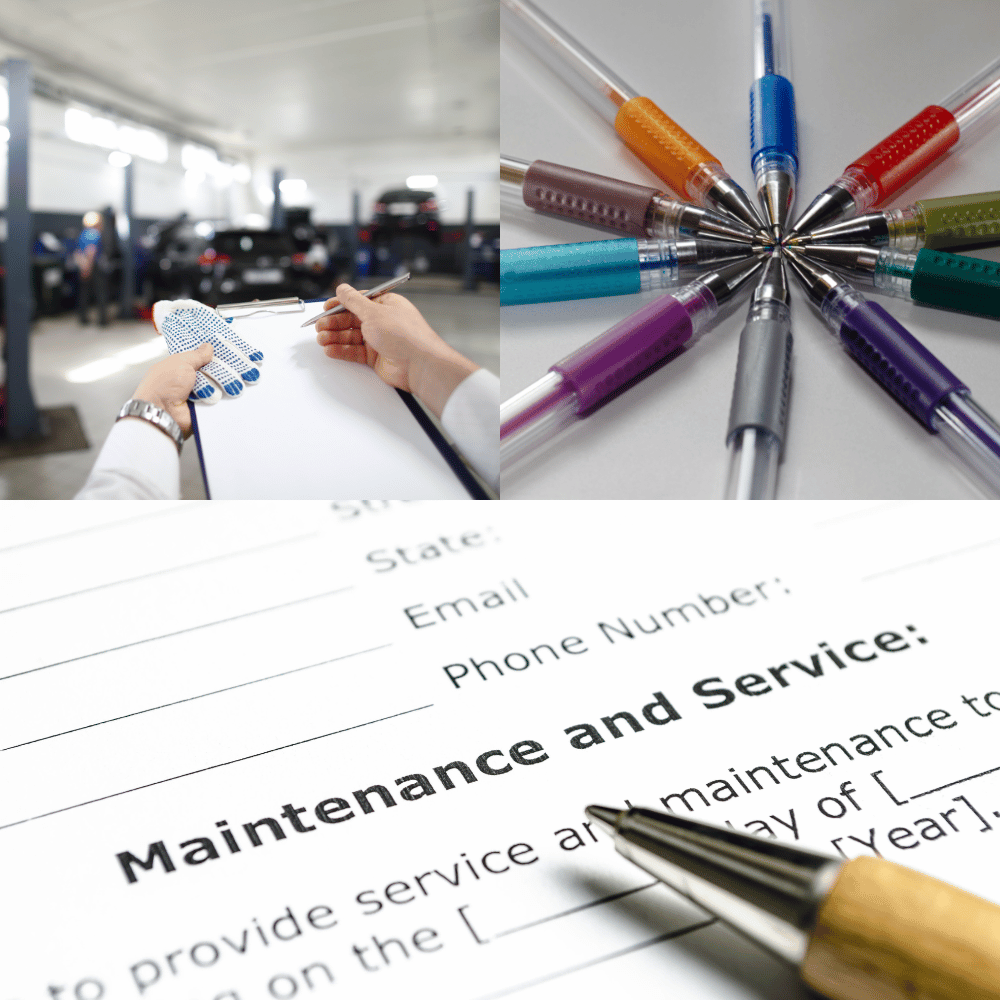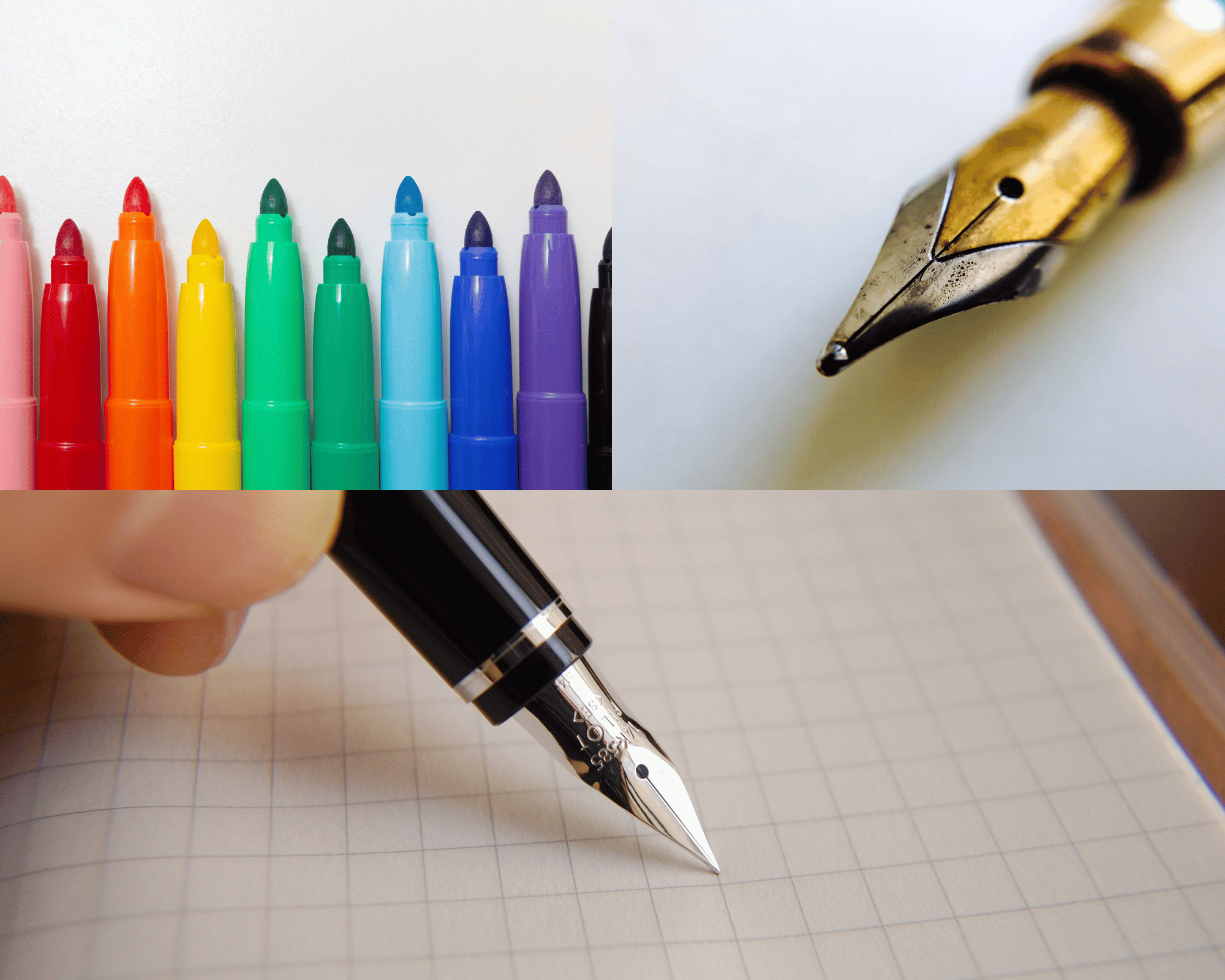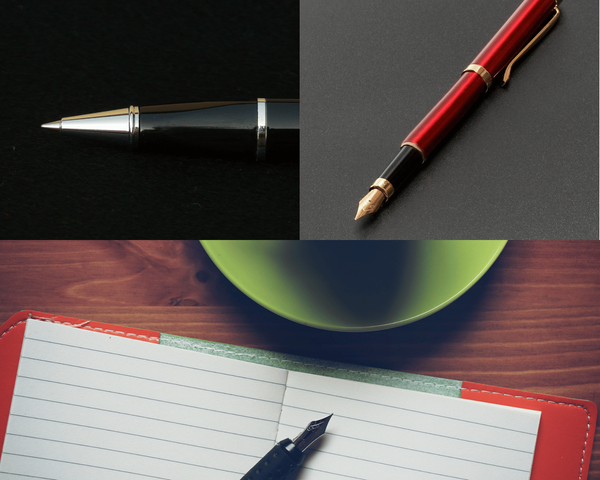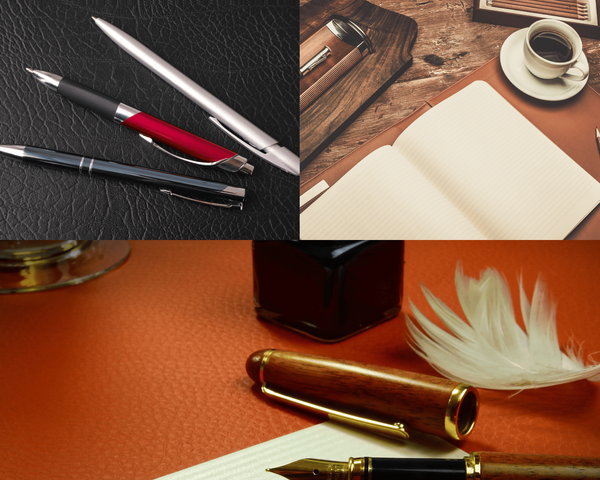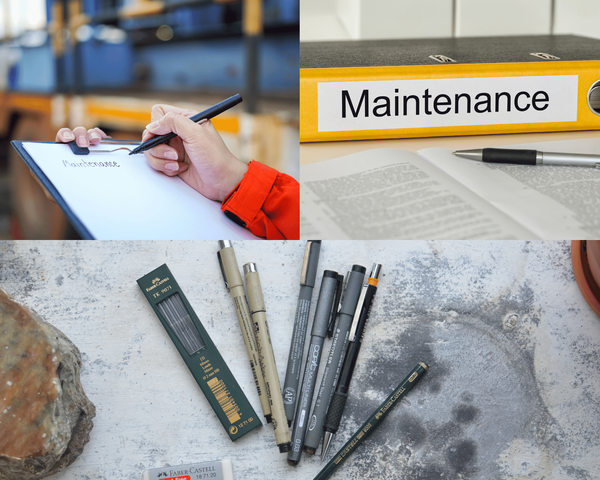Looking to keep your pens writing smoothly and lasting longer? This article covers essential pen maintenance tips, including how to store, clean, and handle different types of pens. Learn how to prevent clogs, leaks, and other common issues with practical advice you can apply right away.
Key Takeaways
- Properly store your pens, especially fountain pens, to maintain ink flow and prevent clogs.
- Regularly clean your pen components, as well as the nib and cap, to ensure smooth writing and prevent ink-related issues.
- Select compatible refills and rotate your pen collection to enhance performance and longevity.
Properly Store Your Pens
Proper storage is the foundation of good pen care. The way you store your pens can drastically affect their performance and longevity. For instance, fountain pens should be kept tip-up or horizontally to prevent ink from leaking and clogging the nib. This method helps maintain a consistent ink flow and reduces the risk of dried ink causing blockages.
Protecting your pens from drops and impacts preserves their precise components. A safe, stable environment preserves your pens’ structural integrity and ensures they are always ready for use.
Cleaning Your Pen Regularly
Cleaning your fountain pens regularly prevents ink residues from drying out and causing clogs, ensuring consistent ink flow. Proper fountain pen maintenance is essential for optimal performance.
Clean your pen about once a week, though this can vary based on your ink type and usage frequency.
Gather Cleaning Supplies
Gathering the right supplies before cleaning is important. Distilled water is recommended because it contains fewer minerals that could potentially harm your pen.
A lint-free cloth, pen flush solution, and ultrasonic cleaner can also be useful.
Step-by-Step Cleaning Process
Empty your pen of any remaining ink and disassemble it. Follow the specific cleaning instructions for your pen type. Flushing fountain pens with lukewarm water can clear most ink blockages. Run the parts under water until it runs clear.
Soak the parts in water for several hours for a deeper clean, especially for stubborn ink residues. Ensure that all ink residues are completely removed by being patient and thorough.
For stubborn clogs, use a pen flush solution or ultrasonic cleaner to effectively dislodge ink residues.
Drying and Reassembling
After cleaning, let all components air dry completely to prevent damage or ink flow issues. Place the components in a dry area and allow them to air dry thoroughly. Some recommend placing the nib down on a paper towel to draw out residual water.
Carefully reassemble your pen once everything is dry, ensuring correct alignment of the nib and feed for proper ink flow. Performing a writing test after reassembly can help confirm that your pen is functioning correctly and that the ink flows smoothly.
Avoiding Extreme Temperatures
Extreme temperatures can damage your fountain pens and ink. Excessive heat can dry out or leak ink, while cold temperatures thicken it and hinder flow. Store your pens in a cool, dry place away from direct sunlight to protect them.
Humidity can lead to the corrosion of metal components in your pens. Keeping your pens in a controlled environment prevents these issues and maintains their excellent condition.
Using Quality Paper
High-quality paper prevents smudging and bleeding, ensuring smooth and vibrant ink flow. Notebooks made with 90 gsm paper, like Rhodia, ink residue, ink reservoir, resist bleeding and feathering, making them ideal for fountain pen use.
Smooth paper surfaces allow the ink to glide effortlessly, enhancing your writing experience with smooth ink flow. Investing in quality paper can greatly enhance your writing experience.
Handling Ink Issues
Ink flow issues can disrupt your writing, with factors like temperature and humidity affecting ink consistency.
Regularly cleaning the nib and feed prevents ink from drying and clogging, ensuring smooth flow.
Flushing with Water
Flushing your pen with water is a simple yet effective method to maintain ink flow. Run the pen under warm water until it runs clear, removing any ink residue. This process clears out dried ink and prevents clogs.
Regularly flush cartridges and converters with clean water for best results. A bulb syringe can enhance the cleaning process by effectively flushing water through the pen’s section, fountain pen depends, pen tip, pen flush ensuring removal of all ink residues.
Using an Ultrasonic Cleaner
An ultrasonic cleaner uses high-frequency sound waves to agitate the cleaning solution, effectively dislodging stubborn ink residues from pen components. It is particularly useful for fountain pens with intricate parts difficult to clean manually.
Place your pen parts in the ultrasonic cleaner with an appropriate cleaning solution. The cleaner ensures that your pen is thoroughly cleaned and ready for use.
Troubleshooting Ink Flow Issues
Simple techniques can resolve ink flow issues. Gently shaking the pen might redistribute the ink and resolve minor problems. If shaking doesn’t work, dried ink, pen cleaning, gel ink rubbing alcohol can help dissolve any clogs inside the pen.
Adding a few drops of water to the ink cartridge can rehydrate dried ink, improving flow. These tips help ensure your pen writes smoothly and consistently.
Maintaining Pen Components fountain pen ink
Maintaining your pen’s components is crucial for its longevity and performance. Regular cleaning and proper storage prevent issues and keep your pen in top condition.
Minimal equipment is needed, fountain pen collection, pen maintenance making these practices easy to incorporate into your routine.
Nib Maintenance
The nib is the heart of your fountain pen and needs regular maintenance for a smooth writing experience. Dust and dried ink flakes can impede the capillary action and cause ink flow issues. Regular cleaning with a soft cloth removes these residues without causing scratches.
A drop of dish detergent mixed with water can be effective for stubborn ink residues. Keeping the nib clean ensures optimal performance and longevity of your fountain pen.
Cartridge and Converter Care
Cartridges and converters are vital for your fountain pen’s ink flow. Storing your pens upright prevents leaks and keeps the nib in good condition. Regularly flushing these components with clean water removes dried ink and maintains smooth flow.
An ultrasonic cleaner is particularly effective for stubborn ink residues. Proper maintenance ensures your fountain pen performs reliably and efficiently.
Cap Cleaning
Cleaning the pen cap is often overlooked in pen maintenance. Rinsing the cap, wiping it with a Q-tip, and drying it upright prevent ink leaks and maintain hygiene. Regular cap cleaning protects the nib from dust and debris.
Make sure all components are completely dry before reassembling to prevent moisture-related issues. This practice maintains the overall cleanliness and functionality of your pen.
Choosing the Right Refills
Choosing the right refills is crucial for your fountain pen’s performance. The performance of a fountain pen depends on compatible and high-quality refills that ensure optimal writing performance. Check the manufacturer’s recommendations to ensure the refills you choose are suitable for your pen.
Incompatible refills can cause ink flow irregularities or make it difficult to secure the cap properly. Selecting the right refills ensures your pen continues to write smoothly and efficiently.
Rotating Your Pen Collection
Regularly rotating your pen collection maintains the functionality of all your pens. Balanced rotation prevents any single pen from drying out or developing flow problems due to inactivity. This practice keeps all your pens in good working order.
Align the number of pens you rotate with your daily writing habits to minimize drying issues. Regular use of all your pens prevents neglect and keeps them performing at their best.
Enjoying Your Writing Instrument
Using a well-maintained pen enhances your writing experience. Regular use keeps the ink flowing and prevents clogs, maintaining your pen’s performance. Capping the pen when not in use maintains its longevity.
Choose compatible refills to avoid performance issues. Taking good care of your pen ensures years of writing pleasure and elegance.
Summary
In summary, proper maintenance of your fountain pen involves regular cleaning, appropriate storage, and the use of quality supplies. These practices ensure that your pen remains in excellent condition and provides a smooth writing experience. By following these tips, you can extend the lifespan of your pen and enjoy its performance for years to come.
Take care of your writing instruments, ballpoint pens, fountain pen maintenance and they will reward you with reliability and elegance. Happy writing!
Frequently Asked Questions
How often should I clean my fountain pen?
You should clean your fountain pen about once a week to avoid ink buildup and keep it writing smoothly. Regular maintenance ensures a better writing experience!
Can I use tap water to clean my pen?
You can clean your pen with tap water, but it's better to use distilled water since it has fewer minerals that might damage it.
What should I do if my pen is not writing smoothly?
If your pen isn't writing smoothly, first clean the nib and feed to remove any dried ink or debris. If that doesn’t help, use rubbing alcohol to clear out any clogs.
How should I store my fountain pens?
To keep your fountain pens in great shape, store them nib-up or horizontally; this prevents ink from leaking and clogging the nib. It's a simple way to ensure they write smoothly every time!
How do I choose the right refill for my pen?
To choose the right refill for your pen, always refer to the manufacturer’s recommendations for compatibility and performance. This will help you find the perfect match!
